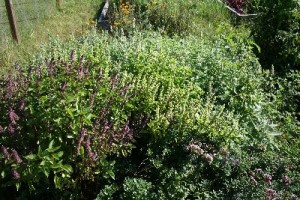
I’d always wanted to grow catnip.
Now I know better.
Innocent little me. I thought I’d grow a few plants, harvest some organic nip for Pierre, and that would be the end of it.
The catnip had other ideas.
I planted three plants in the herb bed, but they looked so small….I planted three more in root vegetable bed, next to the carrots. I’d read somewhere that catnip repels pests from carrots.
And it grew. And grew. And grew.
On Sunday, Hubby asked me to help him with some work outside. We hauled cartload after cartload of compost out to the back lawn, and Hubby sprinkled compost on the bare patches of lawn, then seeded. He asked me if I wanted help pulling up the last of the dead pepper plants in the vegetable garden, so off we went.
“What’s that?” he asked, pointing to a huge silvery green bush that spilled out of the raised bed and onto the pathway.
“Catnip.”
I eyed it. It sneered back at me. It was time for battle.
The catnip had grown. Three tiny plants in each bed had turned monstrous, tentacles reaching into every other herb, swallowing them whole. I took my spade. I whacked. I struggled. I removed four plants, leaving two that I trimmed back to the crowns.
And there among the bed…carrots. Another dozen carrots. Spindly and weak to be sure, but growing all year in the shade of the catnip.
I’m told carrots are all the sweeter from the frost. They’re going to be all the sweeter because I wrestled them away from the catnip that ate the carrots!





Loved this tale! Every gardener has a story about a plant thug — if only we knew when we planted. But is funny later. Thanks for sharing.
I always enjoy spending time reading your blog and your pictures are great. I have your new book on my Amazon wish list. I hope Santa checks that list!
Jeanne, I have a “Best Blog” award for you on my blog. There is no pressure to participate though. I know some people do not have the time or just do not accept awards.
Congratulations you deserve It!
I’ve been surprised at how much growth catnip can put on in a single season.
I grow Nepeta ‘six hills giant’ and ‘walkers low’ and reckon they’re the most versatile plants in the garden. Easy to take cuttings from as well:) assuming you have half a planet or so worth of space for them to grow!